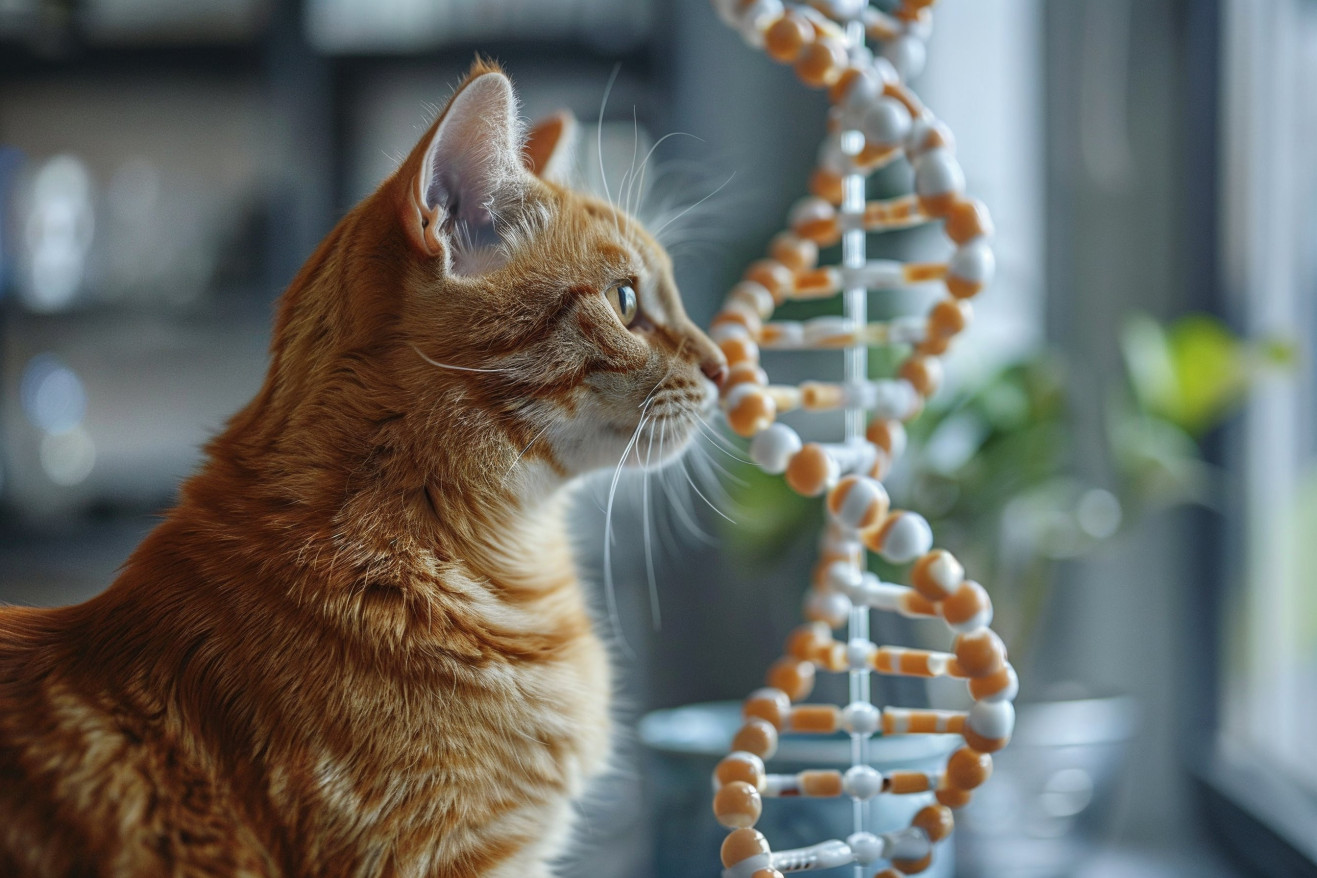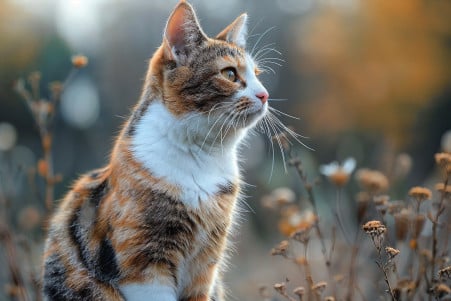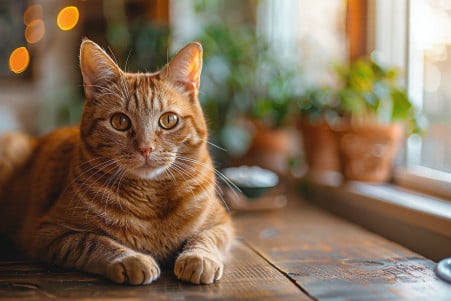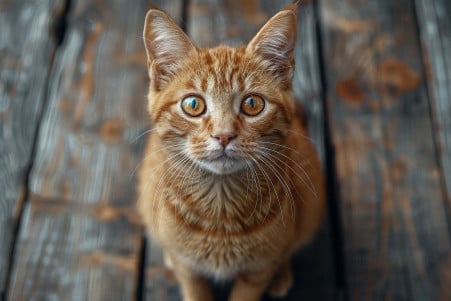Why Are Most Orange Cats Male? The Genetics of Coat Color
18 March 2024 • Updated 17 March 2024

Many people assume that all orange cats are male, but is there a genetic reason for this belief? While not all orange cats are male, about 80% are, and this is due to sex-linked genetics. Female orange cats are much rarer because they need to inherit two orange genes, one from each parent. Male orange cats, on the other hand, only need to inherit one orange gene, and they get it from their mother.
This article will delve into the world of genetic and animal breeding research to explain why there is a connection between coat color and sex in cats. We will look at the science behind sex-linked genetic inheritance and the likelihood of cats having orange fur based on their sex. By the end of this article, you will understand why most orange cats are male and why female orange cats are so rare.
Why are most orange cats male?
The Chromosomal Palette: Genetics of Cat Coat Color
The genetic code of a cat determines the colors of its coat, and two of the most important colors in the feline palette are orange (O) and black (B). These colors are produced by the cat’s genetic code, which includes dominant and recessive genes, according to the Veterinary Genetics Laboratory. These genes, many of which are located on the X chromosome, determine whether a cat will have an orange or black coat.
For a female cat to have an orange coat, she must inherit an orange gene from each of her parents. This is because female cats have two X chromosomes (XX), and the gene for orange is sex-linked and carried on the X chromosome.
On the other hand, a male cat only needs to inherit an orange gene from his mother to have an orange coat (XY), which is why male orange cats are more common.
As a result, the rarity of female orange cats is not just an interesting fact but a genetic necessity that demonstrates the complex relationship between dominance and recessiveness in sex-linked traits. The rules of coat color genetics are important in both cat breeding and population genetics and can affect everything from the color of a cat’s coat to the color of its eyes.
Because of this, the cat coat color palette is a fascinating example of the artistry of nature and the impact of evolution.
Unpacking the Mystery: The Sex-Linked Genetics of Orange Cats
The genetic makeup of orange cats is responsible for their distinctive coloring, and a much larger percentage of males than females are orange.
According to Psychology Today, the reason there are more male orange cats is because the gene that determines whether a cat will be orange is sex-linked and located on the X chromosome. This means that male cats are more likely to be orange because they only need one orange gene on their one X chromosome to be orange.
This genetic explanation also makes female orange cats less common because a female cat needs two X chromosomes, and both of them have to carry the orange gene in order for the cat to be orange.
In addition to genetics, environmental factors and human intervention have led to the regional and breed-specific differences in the number of female orange cats. For example, there is evidence that changes in the environment can lead to changes in the color of cats’ coats over time, which may have an impact on the number of cats with orange fur in different areas.
Inaccurate studies and anecdotal evidence have led to many of the myths about orange cats. For example, the myth that all orange cats are male has led to a lack of awareness about female orange cats, even though they are less common. By combining the information from these studies with the genetics behind them, we can better understand the genetics of cats’ coat colors and the sex-linked traits that determine them.
The X-Factor: Sex-Linked Genetics in Cats
While the orange fur of ginger cats is the most obvious example of sex-linked genetics in cats, these genes are also responsible for a number of other traits.
A paper in Molecular Biology and Evolution by Dr. John McCarrey showed that sex-linked genes are also involved in more general biological processes, including the hybrid male sterility seen in interspecies crosses of cats. This demonstrates that sex-linked X chromosome traits go beyond fur color to affect more complicated reproductive issues.
The idea of dosage compensation is especially important when it comes to sex-linked traits. Dosage compensation makes sure that gene expression is equal between the sexes even though they have different numbers of X chromosomes. This is important for keeping X-linked genes working properly, as otherwise they can lead to a number of genetic issues or traits.
McCarrey’s work on the DXZ4 macrosatellite locus has helped explain the genetic basis of the sex chromosomes’ role in feline reproduction and health. This helps us understand why there are more male ginger cats and puts the broader issue of sex-linked genetic inheritance in cats into context.
Understanding the complexities of these genetic interactions shows that the coat color patterns are just the tip of the iceberg when it comes to the genetics of cats.
The Color Conundrum: How Coat Color Affects Cat Adoptions
It turns out that a cat’s coat color can impact its chances of being adopted. According to a study published in Anthrozoos, a survey of people who had adopted cats from a shelter in California found that people preferred orange cats because they thought they were the friendliest.
While white and tortoiseshell cats were rated as less friendly and more intolerant, which could lead to a bias against them. This bias could lead to a preference for adopting orange cats. Moreover, the study found that biases like the preference for male orange cats based on coat color can have a negative impact on shelter adoption rates.
Meanwhile, another study cited in Anthrozoos found that orange cats were rated as the friendliest, a highly desirable trait for potential pet owners. On the other hand, a report from an urban public shelter found that black cats had the highest euthanasia rates, while orange, brown, and gray cats had intermediate outcomes, suggesting that color biases affect life—and-death decisions beyond stereotypes.
Rescue groups need to work to overcome these biases, which means they need to come up with ways to market cats that emphasize their individual personalities rather than their coat color.
This is especially important for female orange cats, who are rare and whose rarity should be celebrated rather than seen as a marketing problem. Given the impact of coat color on adoption, it’s essential to raise awareness so that all cats have an equal chance of being adopted into loving homes.
Making Sense of the Palette: What We’ve Learned About Cat Coat Color Genetics
Throughout our exploration of the genetics of cat coat colors, one thing has become abundantly clear: the influence of the orange gene on the X chromosome is the primary reason why most orange cats are male. This is because males can express this coat color with only one X chromosome that carries the orange gene, while females need two copies, which makes bright orange females much less common.
The social stigma against orange cats, which has led to them being perceived as loving and desirable pets, has had a huge impact on their adoption rates and people’s preferences for them. This stigma, which is based on historical stereotypes and anecdotal evidence, has the potential to override the importance of a cat’s personality and temperament when people are choosing a cat to adopt.
Knowing the genetics behind these stereotypes and misconceptions is important because it can help dispel them, including the myth that all orange cats are male.
It’s up to all of us to help raise awareness and knowledge that can lead to better breeding and adoption practices. By accepting and understanding the genetic complexities of coat color, we can better appreciate the diversity of our feline companions and ensure that all cats, regardless of their coat color or sex, have an equal chance to find loving homes.


